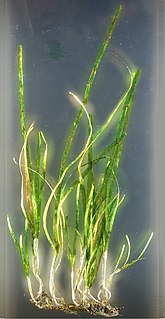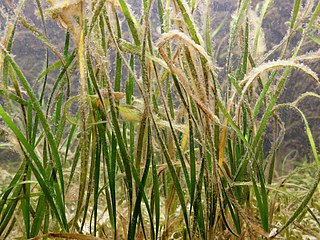
Seagrasses are the only flowering plants which grow in marine environments. There are about 60 species of fully marine seagrasses which belong to four families, all in the order Alismatales. Seagrasses evolved from terrestrial plants which recolonised the ocean 70 to 100 million years ago.

A seagrass meadow or seagrass bed is an underwater ecosystem formed by seagrasses. Seagrasses are marine (saltwater) plants found in shallow coastal waters and in the brackish waters of estuaries. Seagrasses are flowering plants with stems and long green, grass-like leaves. They produce seeds and pollen and have roots and rhizomes which anchor them in seafloor sand.

Halophila johnsonii, or Johnson's seagrass, is a small, asexual seagrass in the family Hydrocharitaceae. It occurs only on the southeastern coast of Florida, and was the first marine plant listed on the United States endangered species list, where it is listed as a threatened species. Female flowers have been observed, but even with decade long observational studies, neither male flowers nor seed have ever been observed.

Halodule is a genus of plants in the family Cymodoceaceae described as a genus in 1841. It is widespread on tropical and semi-tropical ocean shores of all continents except Europe and Antarctica.

Halophila is a genus of seagrasses in the family Hydrocharitaceae, the tape-grasses. It was described as a genus in 1806. The number of its contained species, and its own placement in the order Alismatales, has evolved.
The Seagrasses of Western Australia are submerged flowering plants found along the coast, around islands, and in Estuaries of Western Australia. The region contains some of the largest seagrass meadows in the world, and is the most diverse in the number of species. The variety of habitats along its western and southern coasts is often soft sands in shallow subtropical waters, ideal for these plants.

Phyllospadix, surfgrass, is a genus of seagrass, a flowering plant in the family Zosteraceae, described as a genus in 1840. Phyllospadix grows in marine waters along the coasts of the temperate North Pacific.

Enhalus is a monotypic genus of marine flowering plants. The sole species is Enhalus acoroides. Enhalus is a large seagrass native to coastal waters of the tropical Indian and Western Pacific Oceans. It is the only species of seagrass that does aerial surface pollination in which the pollen and the styles remain dry. Enhalus is surface pollinated with male flowers that detach from the plant to float on the surface until they reach a female flower where pollination can occur. Enhalus acoroides is considered a slow-growing, "climax" species.

Thalassia is a marine seagrass genus comprising two known species.

Thalassia testudinum, commonly known as turtlegrass, is a species of marine seagrass. It forms meadows in shallow sandy or muddy locations in the Caribbean Sea and the Gulf of Mexico. Turtle grass and other seagrasses form meadows which are important habitats and feeding grounds. The grass is eaten by turtles and herbivorous fish, supports many epiphytes, and provides habitat for juvenile fish and many invertebrate taxa.
Halophila engelmannii is a species of seagrass in the Hydrocharitaceae family. It is referred to by the common names star grass and Engelmann's seagrass and grows underwater on shallow sandy or muddy sea floors. It is native to the Bahamas, the Cayman Islands, Costa Rica, Cuba, the Gulf Coast of the United States, the Gulf Coast of Mexico, Puerto Rico, and Trinidad and Tobago.
Elysia serca, the seagrass elysia or Caribbean seagrass elysia, is a species of sea slug, a marine gastropod mollusc in the family Plakobranchidae. Although this sea slug resembles a nudibranch, it is not a nudibranch; it belongs to the clade, Sacoglossa, the "sap-sucking" sea slugs. It was first described by Marcus in 1955 from specimens found in Brazil.

Halophila decipiens, commonly known as Caribbean seagrass or paddle grass, is a seagrass in the family Hydrocharitaceae. It grows underwater on sandy or muddy sea floors in shallow parts of tropical seas.

Halodule wrightii is an aquatic plant in the Cymodoceaceae family. It is referred to by the common names shoalweed or shoal grass, and is a plant species native to seacoasts of some of the warmer oceans of the world.
Halodule pinifolia is a seagrass species in the genus Halodule. It is found in shallow sea waters.
Lobophora variegata is a species of small thalloid brown alga which grows intertidally or in shallow water in tropical and warm temperate seas. It has three basic forms, being sometimes ruffled, sometimes reclining and sometimes encrusting, and each form is typically found in a different habitat. This seaweed occurs worldwide. It is the type species of the genus Lobophora, the type locality being the Antilles in the West Indies.
Zostera novazelandica Setchell is a species of seagrass in the family Zosteraceae found on the shores of New Zealand. It is regarded as a distinct species by some authors but considered as a synonym of Zostera muelleri Irmisch ex Ascherson by others. The Maori names for Zostera novazelandica are karepō, nana, rehia, and rimurehia.
Zostera muelleri is a southern hemisphere temperate species of seagrass native to the seacoasts of South Australia, Victoria and Tasmania. and New Zealand. Today, Zostera muelleri can be found in regions of Australia, New Zealand, and Papua New Guinea, as well as areas of the eastern Indian Ocean, and the southwest and western central Pacific Ocean. Zostera muelleri is a marine angiosperm, and is commonly referred to as eelgrass or garweed. It is a fast growing and readily colonizing species that serves as a feeding ground for wading birds and aquatic animals, and a breeding ground for juvenile fish and shrimp species.
Halophila baillonis is a species of aquatic plant in the family Hydrocharitaceae. It is referred to by the common name clover grass. It is native to Brazil, Cayman Islands, Colombia, Costa Rica, Jamaica, Leeward Islands, Netherlands Antilles, Panama, Puerto Rico, Trinidad and Tobago, and Venezuela. It is listed on the IUCN Red List as "vulnerable" due to its naturally rare occurrence and fragmented populations.

Syringodium isoetifolium, commonly known as noodle seagrass, is a species of flowering plant in the family Cymodoceaceae, growing underwater in marine habitats. It forms seagrass meadows in shallow sandy or muddy locations in the Indian and Pacific Oceans.












